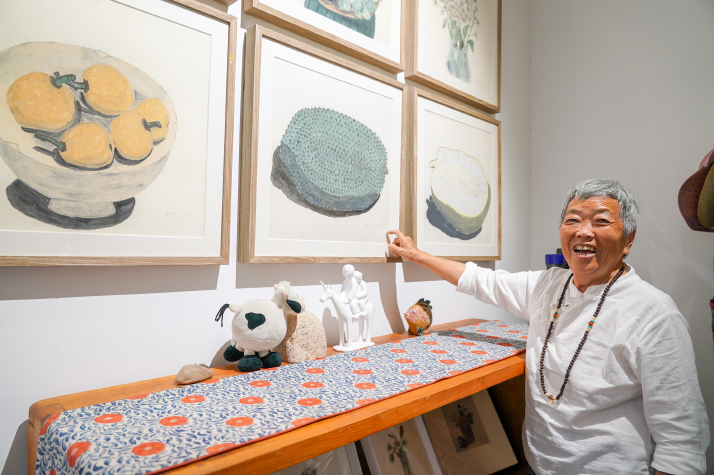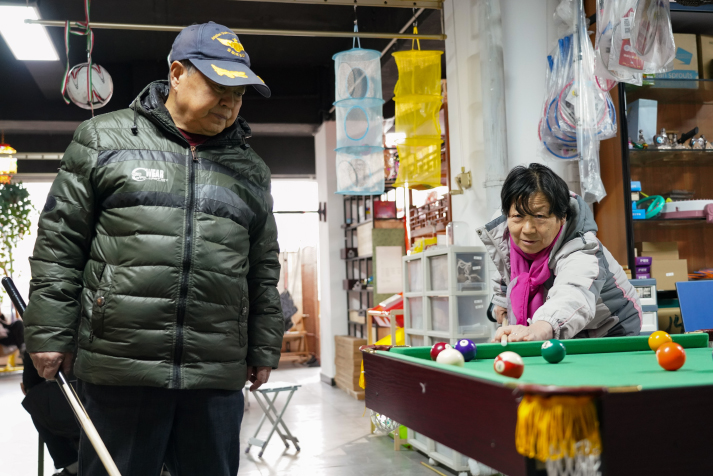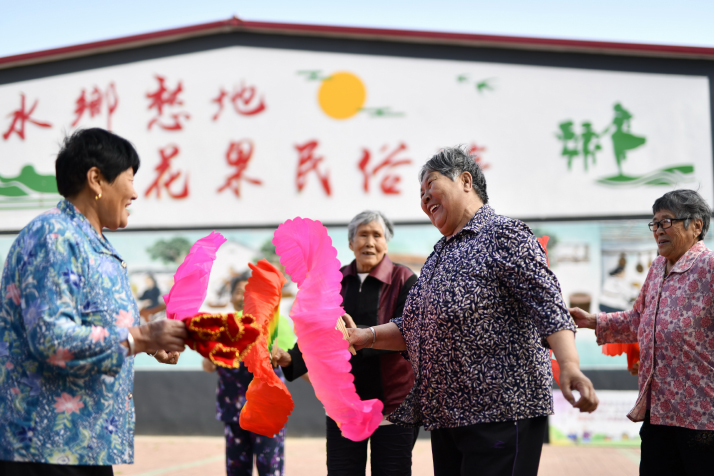| China |
| Dancing and learning, China's senior citizens enjoy their golden years in youthful ways | |
|
|
 An artist introduces her paintings inside a Shanghai gallery on October 14, 2021 (XINHUA)
Guo Chengzhi recently found herself a new hobby—dancing. Before, the 73-year-old retiree's day consisted mainly of visiting farmers' markets, cooking, listening to the radio and watching a little TV. But then, square dancing entered her life. "I was never much of a dancer. But when I went to my neighborhood's park and saw about 50 people all moving in line, stretching or holding their hands up high, I just figured it would be fun; so I gave it a try. And now I'm a regular," Guo told Beijing Review. "Dancing raises the level of dopamine and we can't help but be all smiles!" Living in one of China's coldest provinces, Jilin, where winter temperatures drop to around minus 30 degrees Celsius, Guo still sticks to her hobby during the icy winter, just like many of her boogying friends. China's mainland population had grown to roughly 1.41 billion by late 2021, data from the National Bureau of Statistics showed in January. The number of people aged 60 or over reached 264.02 million, including 190.64 million people aged 65 or above, or 13.5 percent of the total population, according to data from the seventh national census released last May. "The concept of active and healthy aging should become more broadly embraced. The elderly need to know that they can continue to play an active role in society. To achieve this goal, issues related to pension, health, as well as psychological wellbeing and cultural life should be given full consideration," Liu Weilin, President of the China Association of Gerontology and Geriatrics, said during a seminar in January. Light on the feet Different from traditional square dancing—four couples arranged in a square, a style originating in 16th-century Europe, China's square dancing is a well-known collective recreational activity that features spontaneously organized dances across squares, parks, and other open spaces, which is basically public jazzercise. Popular among the elderly and middle-aged, it also features a loudspeaker blasting uptempo pop or folk songs. Square dancing started to gain popularity in China in the mid-1990s when groups gathered at public spaces to dance in the mornings and evenings. Most of these individuals were, and are, senior citizens in search of new friends and activities to keep themselves occupied. The popularity of square dancing got a leg up ahead of the Olympic and Paralympic Summer Games Beijing 2008, when authorities launched the promotion of national fitness activities. It was further encouraged as a good way of exercise for retirees as the State Council in August 2021 released a circular further promoting sports and exercise as part of the country's 14th Five-Year Plan (2021-25). According to the circular, by 2035, China plans to increase the percentage of people who regularly exercise to 38.5 percent, up from 37.2 percent in 2020. According to official statistics, there are presently over 120 million Chinese who regularly take a twirl across the nation's squares. Dancing groups usually form a small society of organizers, lead dancers, and other participants, according to Yang Jun, a professor with the Department of Sociology at East China University of Science and Technology in Shanghai. He has been conducting a survey on square dancing over the past three years, based on the field research of one Shanghai dancing troupe. Yang's study also found that most dancers are happy with their current living conditions, and their ideal situations are consistent with their current ones. "It's about more than just dancing; it's a way of socializing, about meeting new friends and sharing their life trivia with others," Yang told Beijing Review. "It benefits them both mentally and physically." Gradually becoming more a standardized and professional way of exercising, in 2015, four ministerial-level departments, including the Ministry of Culture and Tourism (MCT) and the General Administration of Sport of China (GASC), released 12 government-recommended dance routines. The activity became such a popular pastime that it was included in the 13th National Games in August 2017 in Tianjin. To meet more seniors' needs for improvement, both online and offline training sessions were organized, sponsored or supported by the governments of various levels. Similarly, national and regional competitions were held, sparking popular routines and further spurring the enthusiasm of their aging performers. However, loud music in public places was considered a nuisance in the ears of some living nearby. In recent years, the GASC and the MCT therefore introduced national standards and regulations to render the exercising more public-friendly and further ensure its sound development. The guidelines included standardizing the recommended music volume and permitted practice times. Technological measures were taken to make square dancing more sustainable. In June 2017, authorities introduced special audio equipment for dancers to help reduce noise pollution. These directional loudspeakers limit the transmission of sound waves so the music being played can only be heard by those within a certain space. Some groups use wireless headsets for the same purpose.  Senior citizens play billiards at a gift shop in Beijing on February 24, 2021(XINHUA)
Going digital In addition to their high visibility in parks and other public places, seniors are getting more active in cyberspace. "I spend at least two or three hours swiping away on my smartphone every day, doing some online shopping, chatting, photo retouching, and watching videos of square dancing on short video platforms like Douyin," Guo Lirong, 62, told of her digital life during a seminar on smart technology aiding an aging society. A report released last December showed that among respondents over the age of 60, more than half were using mobile apps for three to five hours a day on average, and nearly 80 percent of respondents used mobile apps for an average of more than three hours a day. But not all enjoy the same adaptability as displayed by Guo Lirong. Jointly released by Nandu Big Data Institute, the Institute of State Governance under Sun Yat-sen University and the China Silver Industry Association, the report also found that over 80 percent of polled pensioners need to be instructed four to 10 times before they can master a new digital skill, but unfortunately members of the younger generation might lack the patience to do so. Zhang Jia is a volunteer with Lanmajia, or Blue Vest, a public welfare campaign launched by government departments and companies like Alipay, China's leading digital payment platform. Stationed in the Lujiazui area in Pudong New Area, Shanghai, her main job is to teach senior citizens how to use a smartphone. At first, Zhang started out by showing them how to register at hospitals, hail a taxi, and pay their utility bills using Alipay, but she soon realized that some of the elderly didn't even know how to connect to WiFi. She patiently taught them and answered any of their questions. "After a while, I noticed some changes; there were fewer and fewer people asking about basic functions, and the apps everyone was using were becoming more and more diverse," Zhang said. In addition to a relatively slow learning process for countless senior citizens, many believe that they are also more susceptible to telecom fraud as their knowledge fails to keep up with the swiftly updated deceptive digital ploys. "My children have always told me to read up on anti-fraud know-how, but aside from that, I'm actually more interested in live-streaming or giving my favorite video a 'like' on social media," Liu Wenming, 62, said. For the elderly, learning how to use the Internet and smart technology will indeed help them obtain the latest information and enrich their personal lives, said Du Peng, Vice President of Renmin University of China. More importantly, it helps older citizens expand social interactions and participate in public development, especially enjoying services on equal footing with the rest of society and further improving their overall quality of life, Du added.  A square dancing group in Luanzhou, Hebei Province, on June 2, 2021 (XINHUA)
Never too old to learn Some seniors engage in learning in a more formal setting. Around 7 a.m., 62-year-old Liu Shujie gets up and prepares for her Chinese calligraphy class at a community college for senior citizens in Kunming, capital of Yunnan Province. About 500 retirees in the neighborhood attend classes at this college, located at an activity center. Liu Shujie has made several new friends there, and they often get together to practice their calligraphy. She also wants to register for a drawing class. "I just want to make the most of this platform; the seniors' college is my second home," Liu Shujie said. In China, the retirement age is currently set at 60 for men, at 55 or 60 for female white-collar employees and at 50 for female blue-collar workers. Average life expectancy is expected to reach 78.3 in 2025, up from 77.3 in 2019, according to the country's 14th Five-Year Plan (2021-25) for public services. The average life expectancy in China rose from 67.8 in 1981, to 77.3 in 2019, read a white paper released by the State Council Information Office. The number of students at China's age-friendly educational institutions had exceeded 10.8 million by late 2019, according to the country's first report on elderly education development. The report also indicated that China had about 76,000 institutions providing teaching services for the elderly as of the end of 2019. In November 2021, the Central Committee of the Communist Party of China and the State Council released a guideline on improving health services in which the elderly were encouraged to take on an active role in society via continued education and greater access to entertainment. According to the blueprint, more age-friendly colleges will be established, as well as national education resource sharing and public service platforms. On the official website of the China Elderly Education Network under the Open University of China, a series of general courses were recently made available, covering disciplines such as art, music, dancing, performing, literature, and tai chi. "The next step is to develop multi-channel and multi-form elderly education to meet increasing demand," said Wu Yushao, an official with the China National Committee on Aging. "At present, county-level age-friendly universities and schools account for a large proportion, but at lower levels [such as township and village levels], these types of educational institutions remain few and far between. Senior schooling should focus on extending to the grassroots community." In these colorful programs, seniors have gained more than enrichment of the mind. It is, after all, the mind that makes the body. (Print Edition: In Twilight, Shine Bright) Copyedited by Elsbeth van Paridon Comments to luyan@cicgamericas.com |
|
||||||||||||||||||||||||||||
|